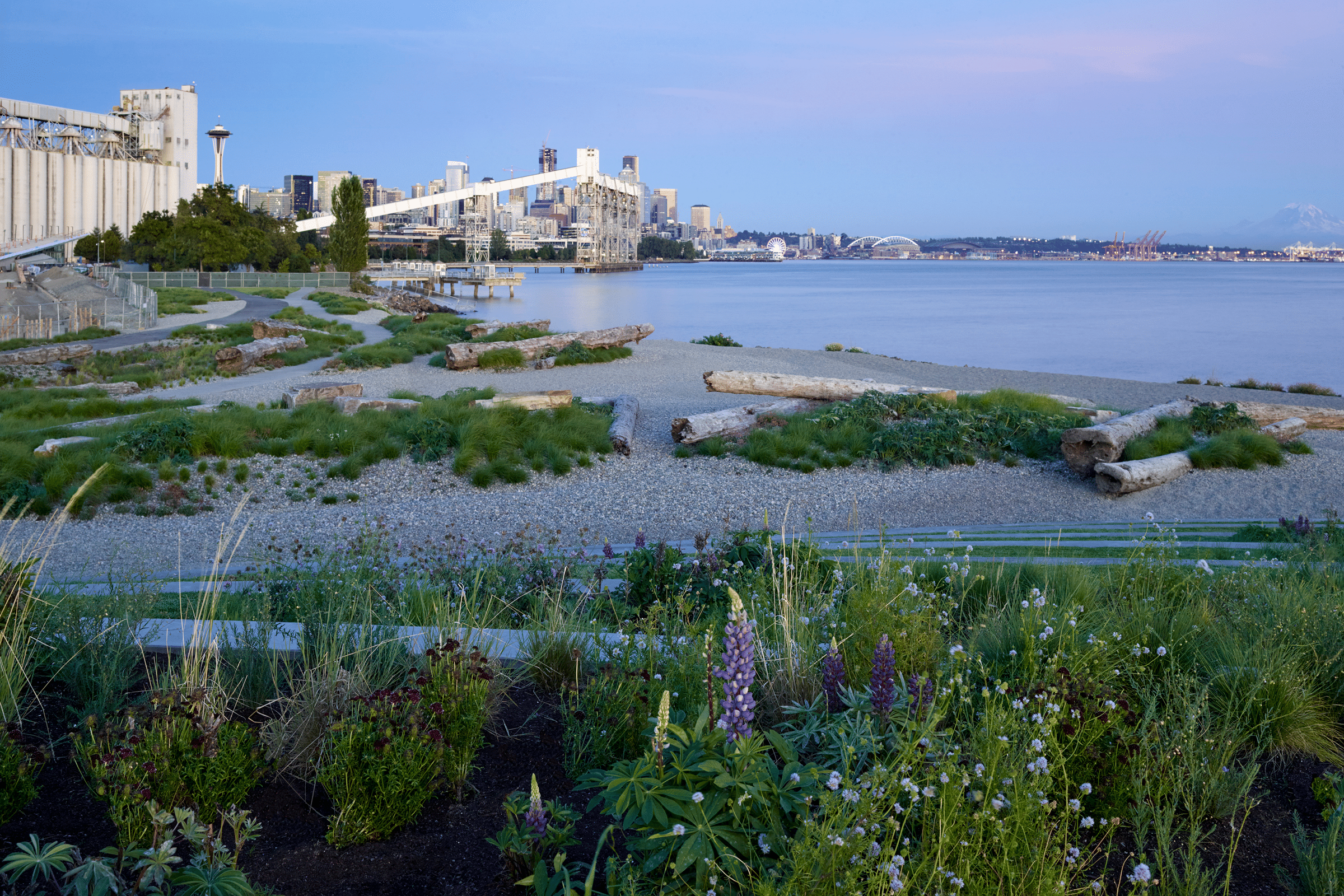Story at a glance:
- The SITES v2 Rating System is a comprehensive rating system for designing, developing, and managing sustainable landscapes and outdoor spaces.
- Prerequisites and credits in the SITES v2 Rating System are divided across 10 categories: site context, pre-design assessment/planning, water, soil and vegetation, materials selection, human health/well-being, construction, operations and maintenance, education and performance monitoring, and innovation or exemplary performance.
- The Beach at Expedia Group was redesigned by Surfacedesign to achieve SITES v2 Gold certification.
Since the introduction of BREEAM in 1990, there has been a veritable explosion of green building rating systems intended to recognize and encourage the design of sustainable structures—but comparatively few certification programs have been developed with the intent of recognizing sustainable landscapes.
One of those programs is the Sustainable SITES Initiative, a rating system that serves as a comprehensive guide to designing, developing, and managing sustainable landscapes and other outdoor spaces.
This article aims to provide an introductory breakdown of the SITES v2 Rating System, its goals, rating categories, and application process.
What is SITES Certification?
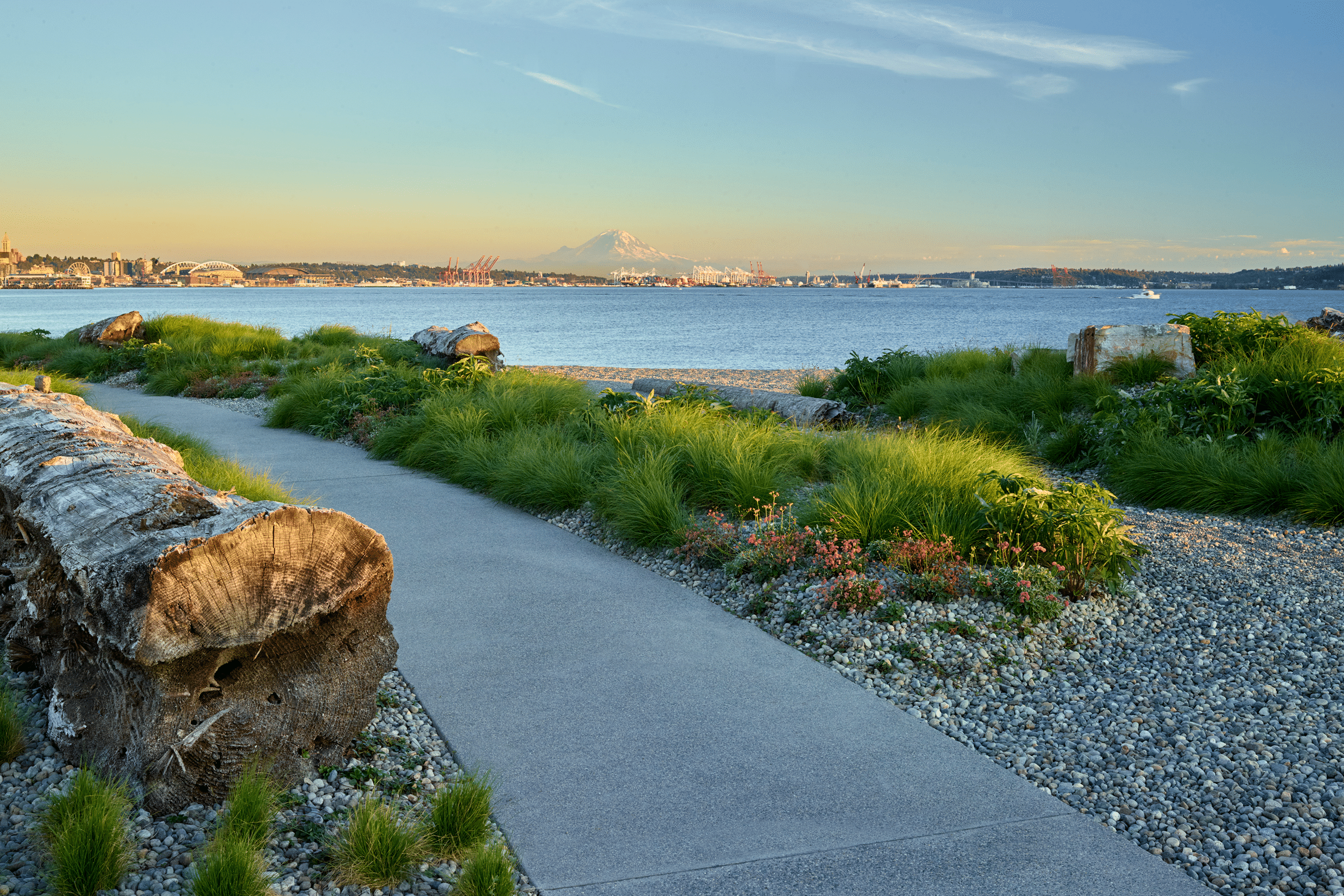
The Beach at Expedia Group is a 2.6 acre portion of the 40 acres of waterfront at the Expedia Group Headquarters that achieved SITES v2 Gold certification. Photo by Marion Brenner
Owned and developed by Green Business Certification (GBCI) in collaboration with the American Society of Landscape Architects Fund, The Lady Bird Johnson Wildflower Center at the University of Texas at Austin, and the United States Botanic Garden, the Sustainable SITES Initiative (SITES) v2 Rating System is a comprehensive rating system for developing sustainable landscapes and other outdoor spaces.
Launched in 2009 and updated in 2014, the SITES v2 Rating System is the ideal tool for designing, developing, and managing sustainable and resilient landscapes as it relies on performance measures instead of prescribed practices, a characteristic that “supports the unique conditions of each site, encouraging project teams to be flexible and creative as they develop beautiful, functional and regenerative landscapes.”
Scoring for SITES certification is points-based, with 200 total points being available across 18 prerequisites and 48 credits. A project must meet all prerequisites to be considered for certification, while all other credits are optional—though seeing as prerequisites are not ascribed a point value, a certain amount of credit points must be approved to actually achieve some level of certification. Projects that go above and beyond with regard to innovation and exemplary performance strategies can earn bonus points as well.
Like LEED, SITES recognizes four levels of certification depending on the amount of points earned:
- Certified (70 – 84 points)
- Silver (85 – 99 points)
- Gold (100 – 134 points)
- Platinum (135+ points)
As of September 2024, more than 360 projects around the world—across 23 countries and encompassing approximately 1.3 billion square feet of landscapes and outdoor spaces—are participating in the SITES program.
What Projects are Eligible for SITES Certification?
The SITES v2 Rating System may be applied to both new construction projects and existing sites that include major renovations, regardless of whether there are any buildings located on-site.
This distinction encompasses:
- Open spaces (local, state, and national parks, arboretums, botanic gardens, et cetera)
- Plazas and streetscapes
- Commercial (corporate campuses; office and retail areas)
- Residential (individual yards and whole neighborhoods)
- Institutional/educational (hospitals, museums, public/private campuses)
- Government
- Infrastructure
- Industrial
- Military
As it stands there is no maximum size for a SITES project, but a minimum size of 2,000 square feet (185.8 square meters) is required for a project to be considered eligible. Additional fees, however, will apply for projects over 100 acres.
SITES Guiding Principles
The Sustainable SITES Initiative was founded on the following principles:
- Do no harm
- Apply the precautionary principle
- Design with nature and culture
- Use a decision-making hierarchy of preservation, conservation, and regeneration
- Provide regenerative systems as intergenerational equity
- Support a living process
- Use a systems thinking approach
- Use a collaborative and ethical approach
- Maintain integrity in leadership and research
- Foster environmental stewardship
Together these guiding principles helped inform and shape the development of specific, measurable criteria for the design and management of sustainable landscapes.
SITES Rating Categories & Criteria
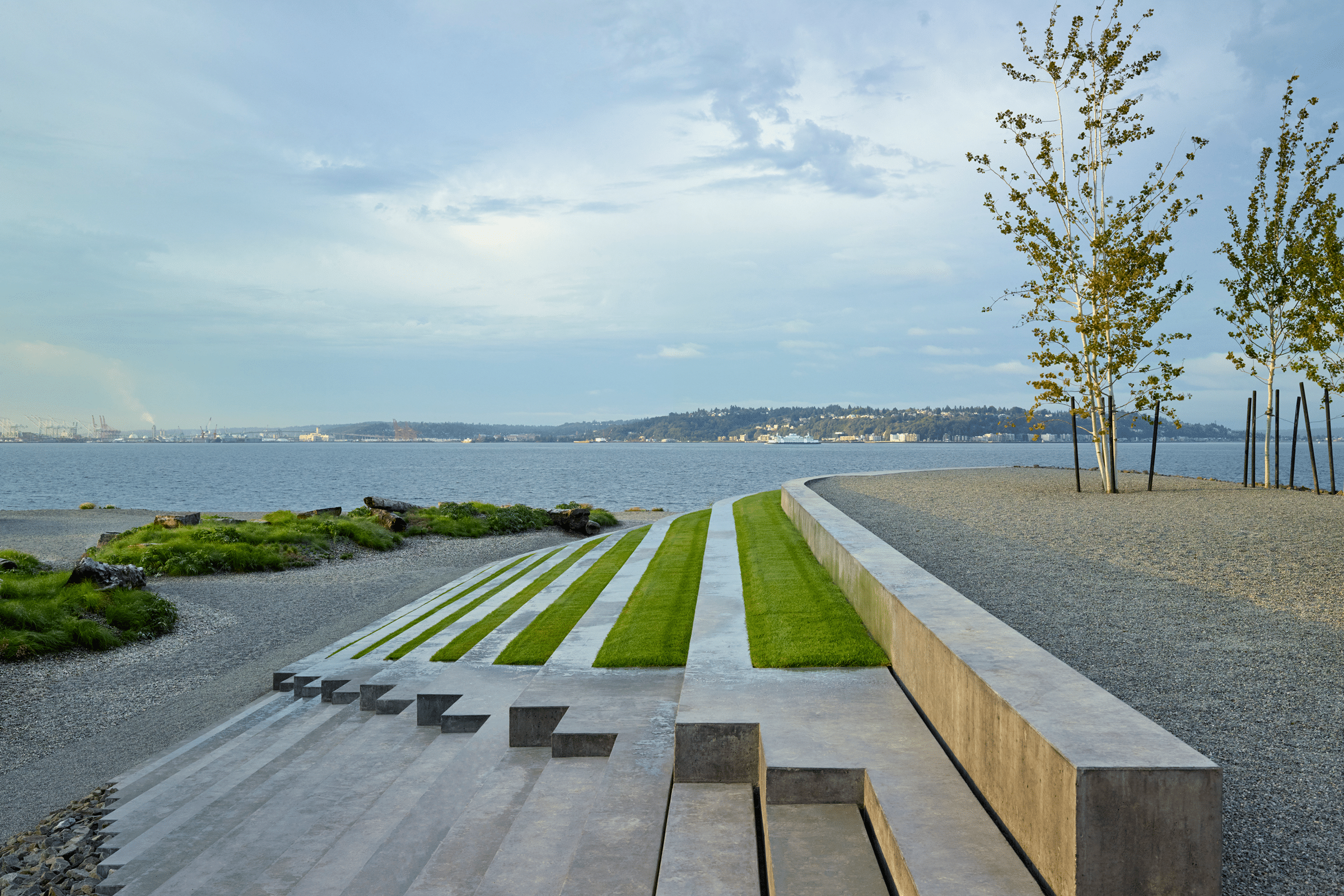
Photo by Marion Brenner
All prerequisites and optional credits in the SITES v2 Rating System (the full guide is available for download here) are separated into 10 distinct categories:
1. Site Context
Before any landscape planning or design starts, it’s important to properly understand the environmental, social, and economic context of a site, or how it fits into and interacts with local ecologies and the community at large.
There are four prerequisites in this section:
- P1.1—Limit development on farmland. Requires projects conserve the most productive farmland soils for future generations by limiting development on areas considered prime farmland, unique farmland, and farmland of statewide importance (as defined by the U.S. Code of Federal Regulations, Title 7, Volume 6, Parts 400 to 699, Section 657.7).
- P1.2—Protect floodplain functions. Necessitates projects take adequate measures to protect floodplain functions (e.g. habitat, storage, water quality) by minimizing development within established 100-year floodplains of all types of waterbodies/courses.
- P1.3—Conserve aquatic ecosystems. Requires projects protect aquatic ecosystems, a distinction that includes both wetlands, deepwater habitats, and areas identified in accordance with the Classification of Wetlands and Deepwater Habitats of the United States.
- P1.4—Conserve habitats for threatened and endangered species. Requires that the project protect local ecosystem functions by avoiding development of areas known to contain habitats for animal and plant species currently listed as threatened or endangered; any areas of the site that do contain such species must be designated as Vegetation and Soil Protection Zones.
For a project to earn credit points in this category, it must combat urban sprawl by redeveloping a degraded site (e.g brownfields), locate itself within an already developed area, and/or reduce pollution and encourage a healthy lifestyle by providing users with access to multi-modal transit networks.
2. Pre-Design Assessment & Planning
Sustainability isn’t something that is worked into a site’s design after the fact, but during the early stages of the planning and pre-design stages. The SITES v2 Rating System identifies three prerequisites within this phase of the project:
- P2.1—Use an integrative design process. Requires the project form an integrated design team, develop a collaborative communication process, identify sustainability principles and performance goals, incorporate said principles/performance goals into a program plan, identify stakeholders and site user groups, plan for construction oversight, and develop a strategy for the preparation of a site maintenance plan.
- P2.2—Conduct a pre-design assessment. In collaboration with the integrated design team, collect and assess information about the site in an effort to identify opportunities for protecting and improving ecosystem services; requires an explanation as to how all identified site conditions will influence the sustainable design of the site.
- P2.3—Designate and communicate Vegetation and Soil Protection Zones. Necessitates the identification, mapping, and protection of sensitive/critical on-site features located within Vegetation and Soil Protection Zones (note that not all projects will include such zones).
There are three optional credit points available in the Pre-Design Assessment & Planning section that may be earned by engaging with potential site users and stakeholders during the design process as a means of supplementing professional expertise with valuable local knowledge.
3. Site Design—Water
As the most-used resource in the world and the element that makes life as we know it possible, water is a key factor in designing sustainable sites and its importance cannot be overstated. An outdoor site’s design influences infiltration and groundwater recharge rates, evapotranspiration levels, and runoff patterns and quality, which in turn impacts the health and well-being of local aquatic ecosystems.
There are two SITES prerequisites that deal with water:
- P3.1—Manage precipitation onsite. Requires projects to reduce negative impacts to channel morphology, dry weather base flow, and surrounding aquatic ecosystems by effectively retaining precipitation on site and replicating natural hydrologic conditions.
- P3.2—Reduce water use for landscape irrigation. Requires that sites reduce (by at least 50% beyond the initial establishment period) or wholly eliminate the use of potable water, aboveground natural water bodies, and groundwater for landscape irrigation purposes.
Sites can go on to earn credit points in this section by taking steps to manage precipitation beyond the baseline requirements, reducing outdoor water use, restoring aquatic ecosystems, and by designing functional stormwater features as amenities.
Stormwater management, water conservation, and aquatic ecosystem restoration were all key components of Surfacedesign’s redevelopment of the The Beach, a 2.6-acre portion of the 40-acre section of waterfront at Expedia Group’s headquarters in Seattle that achieved both SITES v2 Gold and LEED v4 certification.
“Bioretention areas are seamlessly integrated into the topography and planting approach, treating runoff from the [bicycle and pedestrian] paths in compliance with the project’s Salmon-Safe certification while creating habitat opportunities,” Michal Kapitulnik, partner at Surfacedesign, wrote in a previous gb&d article. That Salmon-Safe certification is further testament to Surfacedesign’s efforts at reducing the project’s impact upon nearby Elliot Bay and the Puget Sound, signifying that the site has taken steps to ensure native salmon are able to spawn and thrive in its surrounding waters.
4. Site Design—Soil & Vegetation
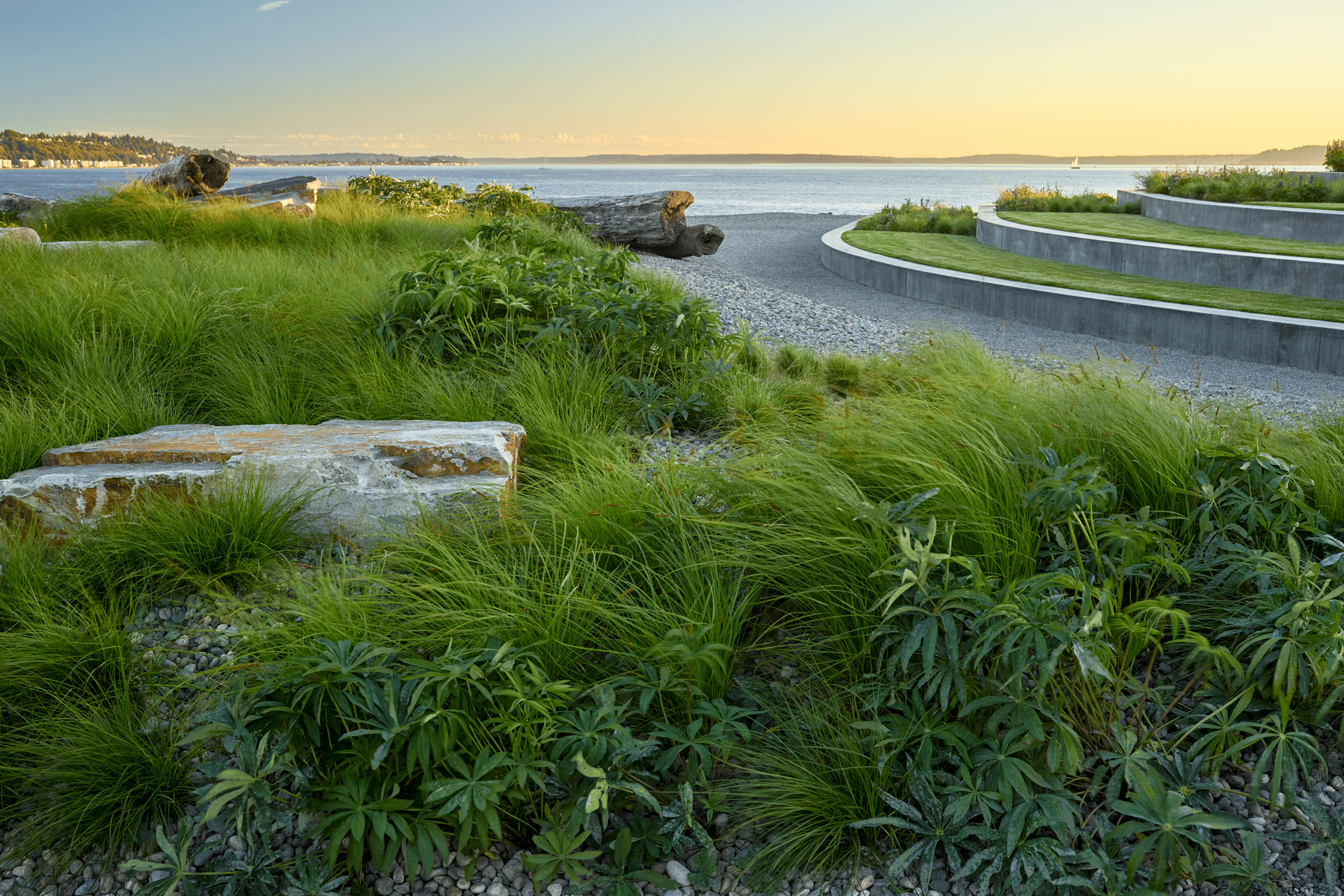
The Surfacedesign project’s planting approach was to use native plants of Puget Sound, as well as plants that increase wildlife. Photo by Marion Brenner
Healthy soil profiles form the literal foundation upon which sustainable landscapes are cultivated, with both the soil and vegetation found throughout an outdoor space having a profound impact on ecosystem biodiversity, erosion rates, groundwater quality, and even daytime temperatures.
The prerequisites for this section are as follows:
- P4.1—Create and communicate a soil management plan. Cultivate healthy plants, ecological communities, and water storage/infiltration by developing a soil management plan (SMP) and communicating said SMP to site contractors through a combination of written instructions and site drawings.
- P4.2—Control and manage invasive plants. Requires that projects limit the damage of known invasive plants on the local ecosystem by developing and utilizing an active control and management plan for on-site invasive species and ensuring that no known invasives are introduced to the site.
- P4.3—Use appropriate plants. Requires that projects only use those plant species—be they native or non-native—appropriately suited to site conditions, climate, and design intent; all plants must be either nursery-grown, legally harvested, or salvaged for reuse.
There are many ways for projects to earn credit points in this category, such as through the conservation and use of healthy soils, appropriate vegetation, special status vegetation, native plants, and native plants communities; optimizing biomass; using vegetation to strategically reduce building energy use; implementing strategies to minimize the urban heat island effect; and taking steps to reduce the risk of catastrophic wildfires.
Soil management and the revitalization of soil health was also crucial to Surfacedesign’s restoration of The Beach. “A comprehensive soil program was developed to build and restore conditions consistent with native soils in the area to support the new vegetation with reduced needs for irrigation, fertilization, and frequent management,” writes Kapitulnik.
“To achieve this soil profiles were designed to rebuild natural conditions, including soil horizons similar to those found in the local natural environment. Taking this approach, the soil profiles were constructed that both reproduce natural function with minimal inputs and also meet site-use demands. This approach established sustainable and resilient soils and planting communities that will continue to grow into natural balance with the Seattle environment.”
Restoring the site’s native soil profiles in turn allowed for the selection of appropriate plant species, of which consist primarily of grasses and perennials indigenous to the Puget Sound region and the Pacific Northwest at large. Native and adapted tree species are also present throughout the site, selected for their hardiness, shade, and seasonal interest. Because the project is Salmon-Safe certified, priority was given to those species that provide wildlife habitats and encourage biodiverse ecosystem growth.
5. Site Design—Materials Selection
Material selection is something that can make or break the sustainability of a site, with many contemporary construction materials having a detrimental environmental impact on both short- and long-term human/environmental health, either as a result of unethical or irresponsible sourcing practices (e.g. slave or child labor, harvesting old growth forests, et cetera), a high embodied carbon, or through the inclusion of toxic ingredients.
The only prerequisite—P5.1—attached to this section requires that the project avoid the use of any and all wood sourced from threatened tree species. Sites can go on to earn credit points in this category by reusing salvaged materials and plants, selecting regional materials, designing for disassembly and adaptability, choosing recycled-content materials, supporting material transparency and ethical extraction of raw materials, and so forth.
Reclaimed materials like stone boulders and locally sourced knotty spruce “boom sticks” from a decommissioned log mill can be found throughout The Beach. “The reclaimed stone boulders and driftwood break up the planting while also functioning as informal seating and play areas,” writes Kapitulnik. “A subtle gradient of beach pebbles and river rocks meander around the planted dunes, recalling Ruby Beach in Washington’s Olympic National Park and the estuaries of the state’s far western reaches.”
6. Site Design—Human Health & Well-Being
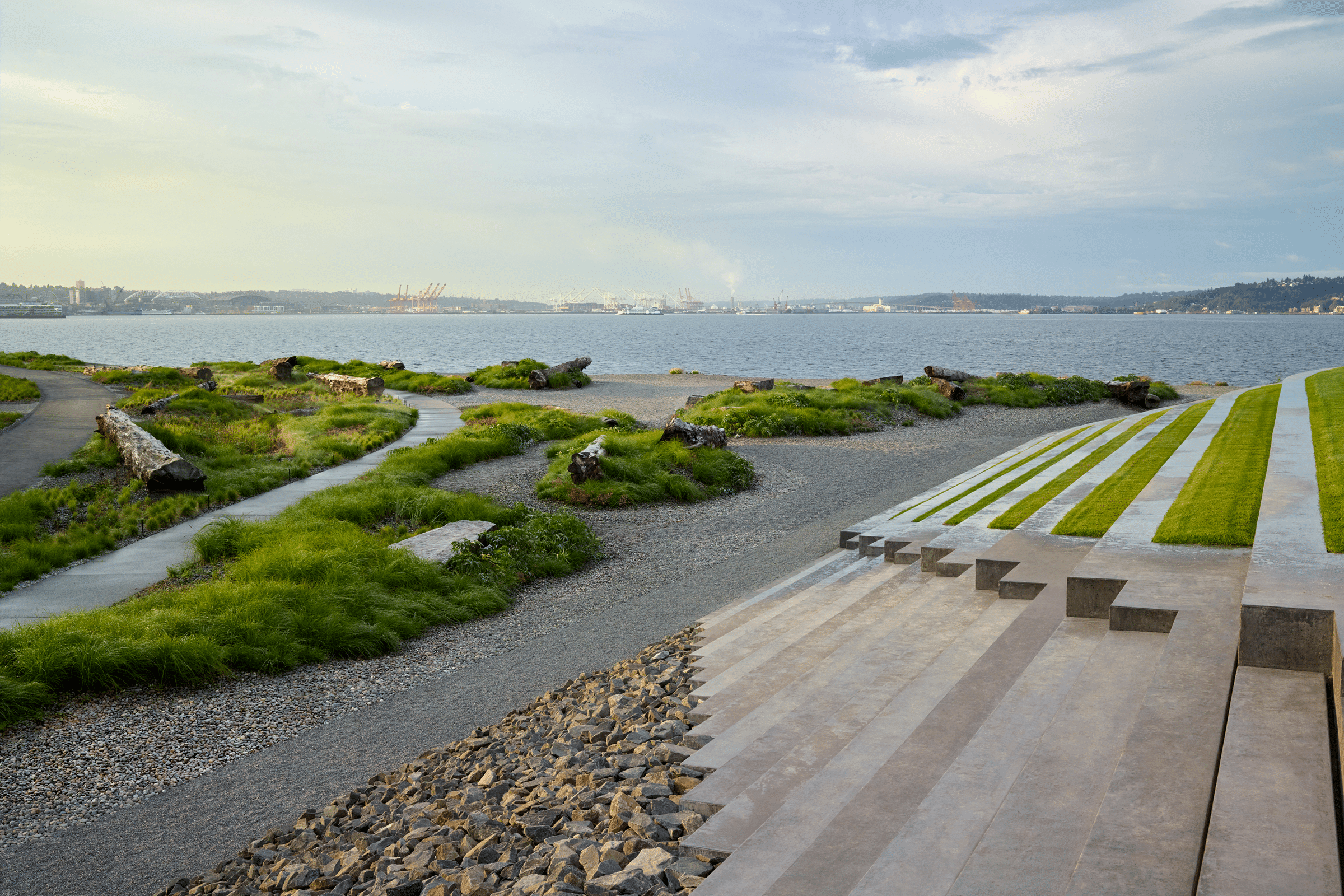
Gravel dunes and a terraced amphitheater aesthetically mitigate storm events, and bioretention meadows naturally filter runoff. Photo by Marion Brenner
The spaces we live, work, and play in have a marked impact on our health and wellbeing—and while outdoor green spaces naturally have a positive effect on our body and mind, those impacts can be amplified in a variety of ways.
There are no prerequisites in this section but projects may earn up to 30 credit points by taking measures to ensure equitable site use, protecting and maintaining historic and cultural places, reducing light pollution, supporting social connection, encouraging physical activity and mental restoration, providing optimum site accessibility, and more.
The Beach, for example, is home to a network of bicycle and pedestrian trails established during a period of prior development. Surfacedesign made significant improvements to these pathways in an effort to ensure they remained safe to use. “Before this project was completed the site’s shared bicycle and pedestrian path had a blind turn that was often submerged during storm events, making cycling or walking along the path dangerous,” writes Kapitulnik. “This new portion of the Elliot Bay Trail separates and expands both a bike and pedestrian path. The paths through The Beach are raised to account for rising sea levels and flood events.”
7. Construction
Regardless of whether a site has built structures on it, the construction phase of any project represents the point at which the surrounding environment typically experiences the most direct disruption—which in turn means there are many opportunities for improving construction sustainability.
There are three prerequisites pertaining to construction:
- P7.1—Communicate and verify sustainable construction practices. Necessitates the designation of an integrated design team member who will be in charge of verifying that the site is built in accordance with the construction drawings and specifications, holding a meeting before construction begins that includes at least one person from each discipline of the integrated design team, and the creation of SITES Punchlist that assigns responsibility for each prerequisite and credit.
- P7.2—Control and retain construction pollutants. Requires that a stormwater pollution prevention plan or erosion and sedimentation plan be created for all construction activities and that the site maintenance plan describes all on-going management activities regarding the protection of vegetation and soil protection zones.
- P7.3—Restore soils disturbed during construction. Requires all soils disturbed during the construction process be restored to a minimum depth of 12 inches in accordance with performance criteria gathered from reference soils; test final soil conditions for organic matter, compaction OR filtration, and soil chemical characteristics OR soil biological function to ensure compliance with SITES requirements.
In addition to these prerequisites, sites can earn credit points by restoring soils disturbed by previous development projects; diverting construction and demolition materials from entering the waste stream; preventing reusable rocks, vegetation, and soil from being disposed of; and by protecting air quality during the construction process.
8. Operations & Maintenance
The SITES v2 Rating System recognizes the importance of achieving sustainability beyond the initial design and construction stages, requiring projects to develop realistic, environmentally-conscious strategies for long-term site operation and maintenance.
The two remaining prerequisites are as follows:
- P8.1—Plan for sustainable site maintenance. Requires the preparation of a site maintenance plan in collaboration with the integrated design team, an explanation of the short- and long-term strategies for achieving sustainable maintenance goals, and that the site manager/maintenance contractor commits to educating all maintenance personnel on the goals and proper implementation of the aforementioned site maintenance plan.
- P8.2—Provide for storage and collection of recyclables. Necessitates conducting a waste stream study to estimate how much recyclable material will be generated on site, the installation of collection containers next to all trash receptacles, a reliable collection service properly attends to all recyclables, and that the site maintenance plan includes the procedures for collecting recyclables on site.
Projects can also earn credit points in this section for recycling organic matter, minimizing the use of fertilizers and pesticides, reducing outdoor energy consumption, generating renewable energy on-site for landscape electricity needs, and by taking measures to safeguard air quality during landscape maintenance activities.
9. Education & Performance Monitoring
After a project is completed, efforts made to educate the public as to the site’s sustainability and/or measure long-term site performance can help projects earn credit points in the Education & Performance Monitoring category.
There are no prerequisites in this category but there are three available credits:
- C9.1—Promote sustainability awareness and education. May be achieved by the provisioning of at least three educational or interpretive features that draw attention to and explain the site’s sustainable features/processes OR providing additional education through the use of interactive educational/interpretive elements, development of sustainability programming, or creation of partnerships with local groups.
- C9.2—Develop and communicate a case study. Requires the creation of a case study that illustrates the strategies, approaches, and benefits of implementing sustainability at the site’s scale and the sharing of said case study with the general public in at least two locations.
- C9.3—Plan to monitor and report site performance. Requires the development of a plan to monitor and report site performance in at least three applicable SITES prerequisites/credits.
A detailed breakdown of these credit requirements and all others may be found in GBCI’s official guide to the SITES v2 Rating System For Sustainable Land Design and Development.
10. Innovation or Exemplary Performance
Finally, the Innovation or Exemplary Performance section is intended to provide projects that go above and beyond the requirements set by SITES with bonus points in recognition of their incredible commitment to sustainability.
- Innovation outside the SITES v2 Rating System. Can be earned by applying and documenting innovative site practices and/or performance benefits that are not expressly outlined in the SITES v2 Rating System.
- Exemplary performance. May be earned by achieving significant, measurable performance above those requirements set by the SITES v2 Rating System (e.g. achieving the next incremental percentage level or achieving double the credit requirements of an existing credit).
This particular credit allows up to three innovations or exemplary performance achievements, each of which is worth three points for a total of nine possible bonus points.
How to Apply for SITES Certification
The application process for SITES certification is similar to that of other green building rating systems and consists of four basic steps:
1. Register
SITES certification starts with registering the project in the SITES Online web portal and providing basic information regarding the project’s details. Upon registration and payment of the registration fee, the user is granted access to vital SITES worksheets and has the opportunity to connect with a GBCI representative.
2. Apply
After registering the project, the user must collect and submit all documentation as required by the SITES v2 Reference Guide. This enables GBCI to review the project for prerequisite compliance and calculate points towards certification. When all documents are submitted, the applicant must email sites@gbci.org and inform them as to whether the project is to be reviewed using a standard or split review process (more on that below).
3. Review
Once the appropriate documents have been submitted, GBCI will conduct a thorough review of the project. If specified, the project may be reviewed in two parts as a split review, in which part of the application is submitted at the end of the project’s design phase and the rest is submitted once construction is completed. This review path is designed to let the applicant know whether the project is on the right trajectory for certification.
Alternatively, the standard review process simply requires the applicant submit all documents after the project’s completion. In either case, there are then two stages of review that the project must go through: a preliminary review followed by a final review.
- Preliminary review. GBCI determines whether the project meets all prerequisites and complies with all attempted credits; the results of the preliminary review may be accepted outright or new/revised information may be submitted for another review.
- Final review. GBCI reviews any resubmitted documents to verify compliance and new credits may be added; the results of the final review may be accepted outright or an appeal may be made.
If desired, applicants can submit appeals against credit reviews and/or submit additional documentation for credits that were not originally approved in the final review. Additional fees apply for each credit appeal.
4. Certify
If there are no appeals to be made and the project has achieved some level of certification, it is up to the applicant to then accept GBCI’s final review, sign the certification agreement, and pay the certification fee in SITES Online. Once accepted, GBCI will send a formal certificate of recognition and the project may be promoted as having earned SITES certification.

